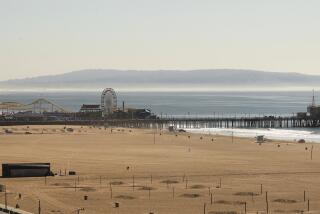Local Development Plan Risks State Rejection : * Government: It conflicts with Coastal Commission standards by favoring the preservation of affordable housing over public access and visitor-serving uses.
- Share via
After a decade of debate, the Santa Monica City Council approved a Local Coastal Plan on Tuesday with the knowledge that it conflicts with California Coastal Commission standards and may not gain needed approval by the state panel.
Despite risking being turned down and thus losing nearly $1 million in state money to restore Santa Monica Pier, city officials stuck with their commitment to preserve affordable housing in the coastal zone. The Coastal Commission favors public access and visitor-serving uses.
“We’ve done enough, thank you very much, for visitor-serving uses,” City Councilman Dennis Zane said. “We want to protect our residents.”
Other policies adopted by Santa Monica that the Coastal Commission generally does not agree with include allowing residents to park in the beach lots under a permit system. State policy is to reserve these lots for beach-goers.
Another bone of contention involves the city’s assertion that it should maintain authority over its general development standards. Typically, the Coastal Commission must approve modifications of such standards. City officials, however, perceive the state panel to be much more receptive to growth and development than are Santa Monica citizens or the city government.
“We maintain we have the right to change standards without coastal approval,” Santa Monica Planning Manager Suzanne Frick said.
Whereas City Councilman Dennis Zane said he thought passage was likely because the city had made enough concessions to Coastal Commission philosophy, Frick was not so confident.
“There are a few significant aspects that the Coastal Commission will have difficulty approving,” she said.
It is important to have the plan certified by the Coastal Commission now because the California Coastal Conservancy, a state planning and funding agency for coastal improvements, has awarded a grant to help renovate the Santa Monica Pier contingent on its having a document signed by the commission.
Santa Monica is among four Los Angeles County cities that have not had their coastal plans certified despite years of hearings, debates and revisions.
State law requires a certified coastal plan for all beach cities. Without it, Frick explained, the city loses its authority to grant building permits in the coastal zone without Coastal Commission approval. In Santa Monica, the coastal zone extends inland to Lincoln Boulevard in the south end of the city, and to 4th Street in most of the rest of the city.
One of the additions to the plan is new zoning for coastal parking lots, which will be designated as open space or parking lots as a way of protecting the properties from commercial development.
Santa Monica succeeded this week in fending off an attempt by restaurateur Michael McCarty to revive a plan to build a luxury beach hotel by getting the state to step in and retake control of state-owned beach property now leased to the city.
If the new zoning is adopted in the certified Local Coastal Plan, any move to build a hotel or another large commercial establishment would require an amendment to the plan, a complex, time-consuming and expensive process.
Also included in the thick document is an open-ended concept for the controversial sculpture program for the beach, known as NES Park. The City Council retains the right to select individual pieces of art. A motion by Councilman Robert T. Holbrook to keep the artwork off the sand died for lack of a second.
Councilman Kelly Olsen was the only council member who voted against the Local Coastal Plan.
Councilman Herb Katz absent.
Frick said the plan will be presented to the Coastal Commission staff next month, with action expected after the first of the year.
More to Read
Sign up for Essential California
The most important California stories and recommendations in your inbox every morning.
You may occasionally receive promotional content from the Los Angeles Times.













